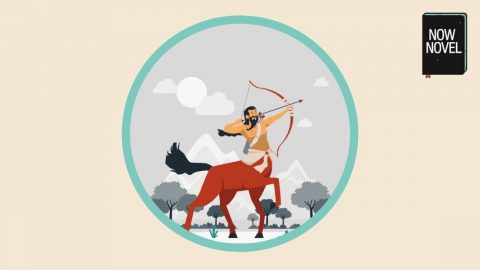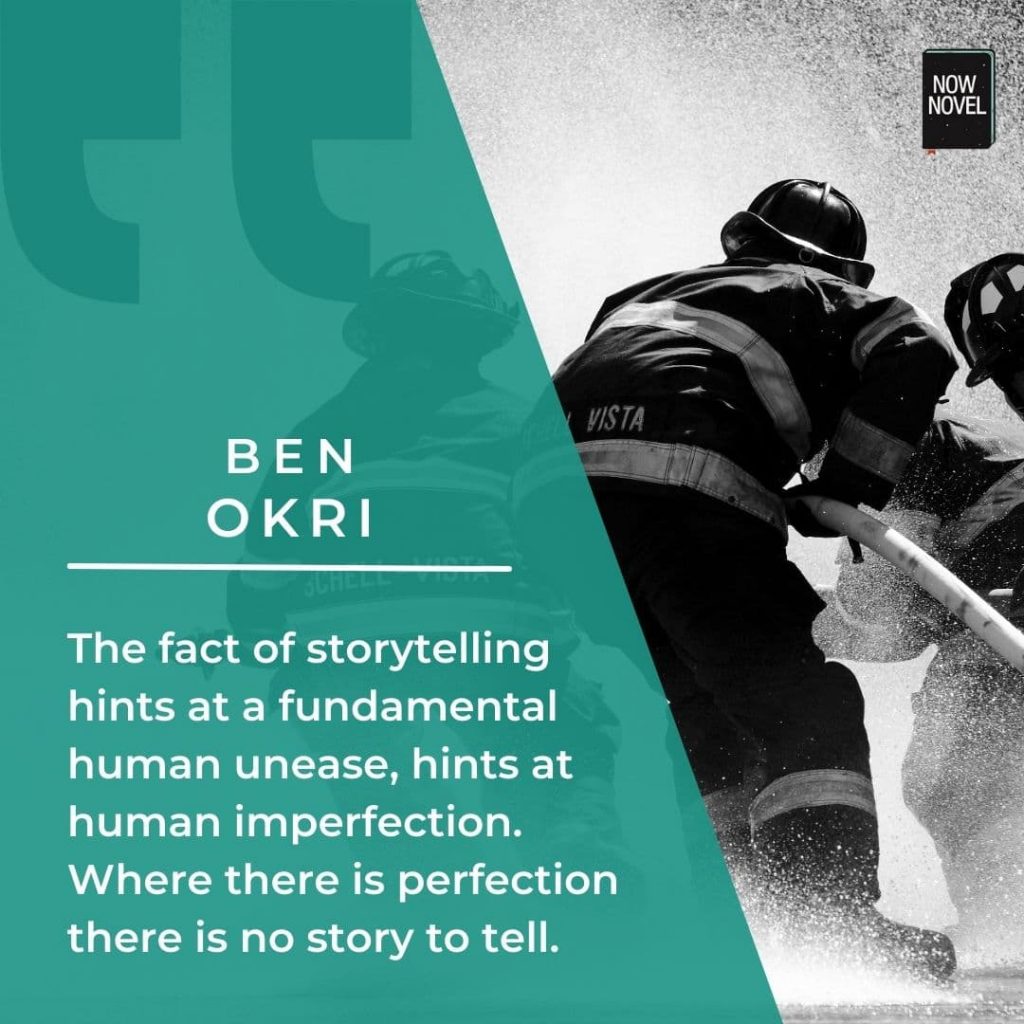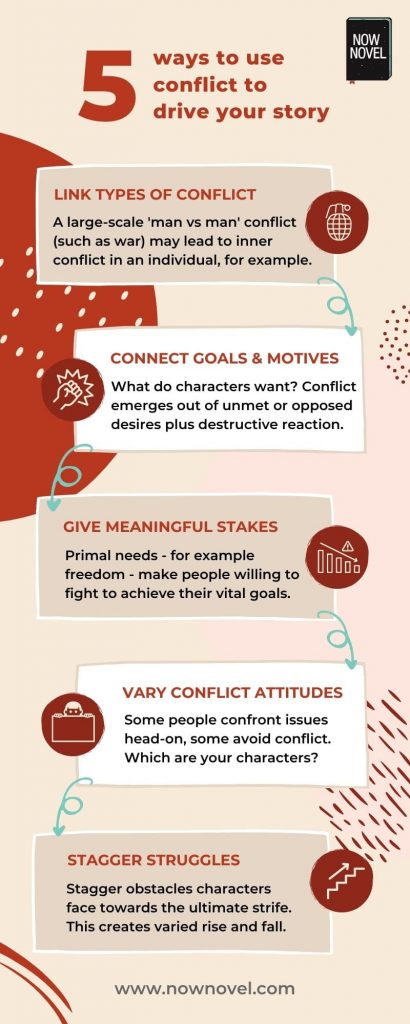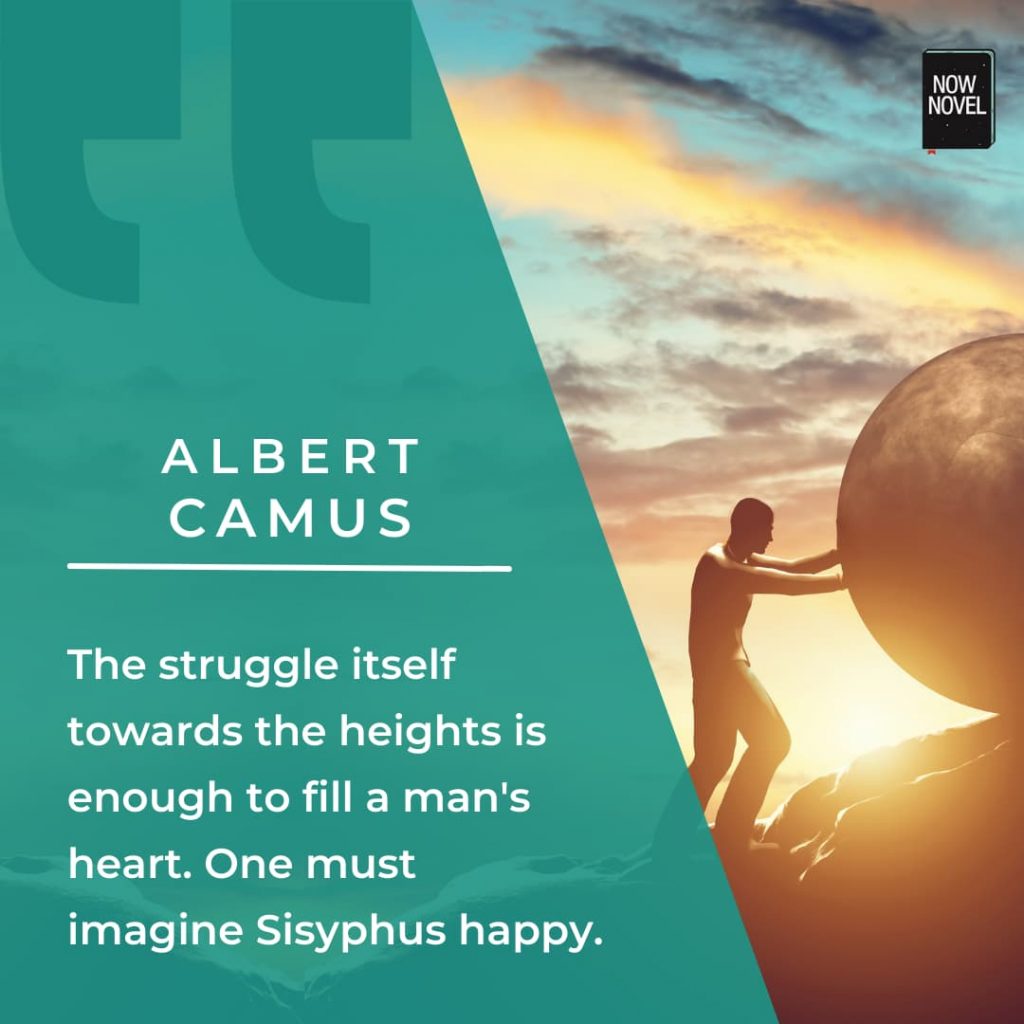The central conflict of your story is the primary opposition that stands between a character and their goals. Learn what the main conflict is and why it matters. Find ways to use conflict to propel your story to a resolution or ‘to be continued…’
What is a central conflict?
The definition of a central conflict in a novel, play, film or TV script is ‘the core struggle a main character (or a group of characters) faces’.
The main conflict in a story may be external (between characters and other characters or characters and their environment) or internal (a struggle within) or may combine external and internal elements.
This primary conflict is typically what drives action towards the story’s climax. It supplies the reason for the story to begin, and for it to proceed towards its ending.
Examples of primary conflict
The central conflict in Tolkien’s The Lord of the Rings cycle, for example, is the struggle between the Hobbits and their friends and the cycle’s villain, Sauron.
The antagonist seeks a magical ring that could restore much of his lost power if he recovers it. The ensuing quest to destroy the One Ring sets up contrary goals between the protagonists and the antagonist or villain.
‘Conflict’ isn’t necessarily combative or violent opposition and struggle, though.
In a romance novel, the central conflict may be whether or not potential lovers will end up together, for example.
In a murder mystery, the central conflict consists of the obstacles, detours and dangers that stand between detectives and the killer they need to identify and bring to justice.
How to use a central dramatic conflict
- Identify relevant major conflicts and lesser obstacles
- Explore types of conflict in literature
- Connect character goals, motivations and conflicts
- Give story conflict meaningful stakes
- Vary character attitudes to conflict
- Stagger struggles towards a major conflict
- Play with internal and external obstacles
Let’s dive in and explore using conflict to drive stories:
Identify relevant major conflicts and lesser obstacles
How do you use a central conflict to drive the action of your story?
Start by finding ideas for major conflicts and minor struggles along your characters’ way. Ones that are relevant to your story idea.
For example, take this The Devil Wears Prada -inspired story idea:
‘Hannah lands an internship at a prestigious fashion magazine and dreams of becoming a fashion editor’.
What is the major obstacle or ‘why not’ that could make Hannah the intern not attain her goal? (read more on the connections between goals and conflicts below).
Obstacles would likely involve situations that prevent Hannah from proving her competence or ability.
The largest struggle could be between:
- Hannah and her critical, withering boss who is nearly impossible to impress (while Hannah’s promotion rests in her hands)
- Hannah and an upcoming edition of the magazine involving an impossible number of tasks with complex requirements
How to find lesser obstacles that connect to a major conflict
Lesser obstacles will typically arise on a person’s path as they pursue a goal.
These are great to mine for secondary conflicts that sustain drama and suspense.
This is where it helps to go into research. If you don’t know your story’s world well, read books set in similar worlds. Take note of the types of minor conflict authors use.
Look to journalism and news articles for insights, too. For example, BBC Culture has an article on fashion and sustainability.
Hannah (from the example above) might struggle with:
- Demanding, willfully obstructive departmental staff at the fashion magazine
- Crushing deadlines, each dependent on another Herculean task
- Last-minute changes, issues with creative talent not showing up or having problems of their own that contribute to the chaos
- The magazine’s sustainability angle being just PR while they make awful ecological choices she feels strongly against
Brainstorm lists of possible rising action scenes that test your characters’ resolve.
Explore in scenes why a person might either abandon or adjust their goal, given the obstacles in their way.
Brainstorm rising action elements that connect to your characters’ goals in the ‘Plot’ section of Now Novel’s story outlining dashboard.

Develop your story
with guidance
Join Now Novel to connect with a writing community, meet mentors, and trade crits.
Learn MoreExplore types of conflict in literature
There are many types of conflict in literature.
Each type of story conflict provides a way to create drama. ‘An exciting, emotional, or unexpected event or circumstance’ (definition of drama via Oxford Languages).
The (somewhat dated) use of ‘man’ to mean any person or character is often used to describe the major types of conflict in the format ‘man versus…’:
- Man
- Self
- Nature (or wild/environment)
- Society
- Technology
- Supernatural forces
Having multiple conflict types provides a way to vary the source, nature and stakes of your story’s dramatic action, so that conflict in drama isn’t monotonous.
Examples of man vs man struggles in stories
Man vs man (or character vs character, group vs group) is one of the most common conflict types.
Examples of man vs man conflict include:
- David vs Goliath (in Biblical scripture)
- The White Witch versus the inhabitants of Narnia and the Pevensie children in The Lion, the Witch and the Wardrobe by C.S. Lewis
David versus Goliath is a classic case of an ‘unfair’ or ‘unequal’ seeming match (Goliath’s greater size and physical strength relative to David).
In C.S. Lewis’s beloved fantasy classic, the White Witch Jadis creates an environmental conflict between Narnia’s animal inhabitants and their landscape. She uses magic to make it eternally winter in Narnia. The Pevensie children’s quest is to stop her and restore seasonal change – a kinder, more habitable world.
This is a good example of ways you can use one type of conflict to lead into or complicate another type. The White Witch’s grasping at personal power worsens’ Narnia’s animals’ struggle for survival against their own environment in general. Conflict begets conflict of other types.
Examples of man vs self conflict
Man vs self conflict describes an internal struggle.
A classic example of this would be the werewolf figure, whose transformation is often a frightening or painful experience they may try to avoid for various reasons (such as not being found out).
Conflict within a person is often found in stories where people battle with mental health or the after-effects of personal trauma which leads to mental conflict.
Man vs self conflict from well-known books:
- Septimus Smith in Virginia Woolf’s Mrs Dalloway (1925). A World War I veteran who suffers from shell shock and PTSD and has grown distant from his wife Lucretia because of his fragile mental state
- Rodion Raskolnikov in Dostoyevsky’s Crime and Punishment (1866). A penniless student who murders a pawnbroker in the early pages of the story and is tortured by his guilty conscience thereafter
The examples above are interesting to compare. A large-scale conflict that engulfs European society (World War I) produces Septimus Smith’s internal conflict as a consequence in Woolf’s moving novella.
In the second example , Rodion’s inner turmoil leads him to a terrible act which pits him against society’s moral and ethical laws. The internal strife leads outward to broader conflicts.
Through these examples, we see the complex ways societal violence leads to inner strife, or inner strife may put a person in conflict with their society.
Examples of man vs nature conflicts
Man vs nature is a classic feature of adventure fiction. Think for example of:
- Robinson Crusoe surviving being stranded on an island or a similar fate meeting the boys stranded in William Golding’s The Lord of the Flies
- A man trapped between rock faces having to sever his own limb to survive in the autobiography Between a Rock and a Hard Place by Aron Ralston (adapted as 127 Hours)
Stories of island stranding and survival abound in stories during and after the Age of Exploration (and many postcolonial stories counter the assumptions about indigenous others and empire often made in these narratives).
Examples of man vs society conflicts
Man vs society conflicts often involve characters who are outsiders and break their society’s taboos or codes.
Examples of man vs society conflicts
- Hester Prynne in Nathaniel Hawthorne’s The Scarlet Letter (1850) who is forced to wear a scarlet ‘A’ symbol after having a child out of wedlock in Puritan Massachusetts
- Meursault in Albert Camus’ The Stranger, a French settler living in Algeria who ‘is condemned because he does not play the game’ society dictates (in Camus’ words) and kills a man on the beach after an argument
This type of story conflict is common in stories where the protagonist is an iconoclast or rebel who shuns society’s norms.
Examples of man vs technology conflicts
This is a familiar type of conflict to science fiction fans. It is common in stories that ask questions about technology and ‘scientific progress’ (and the potential conflicts that could arise via our pursuit of it).
Examples of man vs technology conflict:
- In Isaac Asimov’s short story The Evitable Conflict, powerful computers designed to handle economic affairs in four regions on earth start to make ‘errors’ that harm humans (intentionally, it turns out, in order to safeguard humanity’s future)
- In Arthur C. Clarke’s Rendezvous with Rama (1973) the conflict is with the unknown itself, as spacemen investigate a mysterious cylindrical craft orbiting distant planets but find only semi-biological robots that seem to be drones and a holographic library
The second example reminds us that the central conflict of a story can be as simple as the question ‘why?’ in a struggle to understand the unknown.
Keep in mind that a story that has a subtler central conflict may read as more inaccessible or cerebral to the average reader and may thus have a more niche audience.
Examples of man vs the supernatural
Supernatural horror is full of stories about the unknown.
Examples of supernatural conflicts:
- In Stephen King’s Thinner (1984), a lawyer is punished with a curse after knocking down and killing a pedestrian that causes him to lose weight inexplicably no matter what he does
- In George R. R. Martin’s A Song of Ice and Fire series, a wall separates the seven kingdoms of Westeros from deadly supernatural beings introduced as ‘Others’
Tips for using different types of conflict to drive your story
- Decide which types are possible in your world (in realist 18th Century historical France, you can’t, of course, have self-replicating robots or space travel).
- Think how conflict types impact other conflict types: What toll does a global conflict such as a world war take on an individual’s mind? How will a group of kids stranded on an island react to the same crisis and an environment with no rulebook, given their different personalities and backgrounds?
- Consider combining conflict types for depth. In a survival story, for example, characters facing a ‘man vs nature’ conflict may bicker between themselves and disagree how best to build shelter, scavenge sustenance, and so on.
Connect character goals, motivations and conflicts
Goal, motivation and conflict are three aspects of a character arc that are closely related.
For there to be conflict between people, a want or need has to be unmet, and there must be a reaction to it.
Goal, motivation and conflict: Crown of Midnight
Take, for example, Sarah J. Maas’ Crown of Midnight (2013).
An assassin named Celaena, a former slave, must win her freedom by killing every person the king asks her to. Yet she does not want to kill for the king and fakes the required deaths, though this endangers her friends.
In this example we have:
Goal: Satisfying an assassin’s contract.
Motivation: Winning freedom.
Conflict: Celaena’s inner struggle between her desire to attain freedom and her desire to behave justly and ethically.
Because Celaena has such a powerful motivation (freedom), the character has a strong reason to carry out her duty. She resorts to deception (faking her targets’ deaths) to fulfil both her external obligations and her personal sense of responsibility, to resolve her inner conflict.
The choices your characters make out of their inner conflicts give rise to scenarios and situations involving further conflicts (Maas’ reader may ask, ‘What happens when Celaena’s deception is found out?’).
Knowing your characters’ goals, motivations and inner conflicts will help you find scene ideas that illustrate your characters’ most urgent needs and desires and maintain your reader’s suspense.
Give conflict meaningful stakes
‘Stakes’ are a critical part of conflict. What is at stake if a character does not meet their goal?
As Now Novel writing coach Romy Sommer says, the highest stakes in a story are primal. The most critical needs of a person – needs such as food, freedom – are those they will go far to attain or preserve.
Writing exercise: Finding stakes and conflicts
Take one of the six conflict types outlined above (man vs man, self, nature, society, technology or the supernatural).
Brainstorm potential conflicts in your chosen category (for example, ‘man versus mysterious pandemic that turns everyone into blood-sucking zombies’).
Now make a list of possible stakes: What could happen if this situation were allowed to continue? What does a main character in this situation stand to lose?
Vary character attitudes to conflict
Another aspect of conflict that drives drama is how people’s attitudes towards conflict differ.
Some people prefer to confront head on. If there is an argument, they want to solve it now. Others are conflict-avoidant. They shut down the other (or themselves) or run away.
Differences between characters’ attitudes in a romance story often provide the minor conflicts along the way.
The central conflict of a romance might be a confrontational main character and their conflict-avoidant love interest butting heads until they find a way to communicate and engage in (and pass through) moments of disagreement or tension constructively.
Stagger struggles towards a major conflict
It is useful to think about story conflict together with the idea of story arcs. Varying conflict intensity creates the rhythm of real relationships.
If every fight is a screaming match, we’re in soap opera territory (which is fine, of course, if this is your chosen genre).
To take the simplest example, the fable ‘The Three Little Pigs’ does not begin with the wolf getting boiled alive in the smartest pig’s pot. If it did, the story would have nowhere to go. It would go zero to a hundred way too fast.
It is helpful to think of conflict in your story in a sequence of connected events or beats such as:
- Goal: What a character wants to do
- Action: What your character does out of this desire
- Outcome: If the outcome is an undesirable one to the character, this is typically some kind of setback. For example, the love interest becomes unsure, the enemy hideout has more guards than anticipated.
- Reaction: How your character learns from the outcome of the action and comes back stronger and wiser (or makes things worse before they get better).
If you stagger destructive outcomes and uncertainties so that the most destructive outcome or greatest uncertainty comes last, you then have a story arc towards your climax and story resolution.
Play with internal and external obstacles
As discussed in the examples of Septimus Smith and Rodion Raskolnikov above, internal conflict may lead into external and the reverse, too.
Creating a thorough character profile provides a useful way to question who a character you’ve come up with is. What formative experiences shaped their inner struggles (or strengths)? How will this impact how they instigate or react to conflict?
What is an example of one of the conflict types above you found intriguing in your own reading?
Use the Now Novel dashboard to outline stories and develop characters, plots and conflicts in structured steps (with extra help when you upgrade your membership).
I took the “Kickstart Your Novel” online class which was a great value and really gave me the motivation to get going. The best advice I received through that was to “write a crappy first draft” and let people read it. That might sound odd, but really, it was invaluable advice, especially for a mystery novel. — Bonnie





